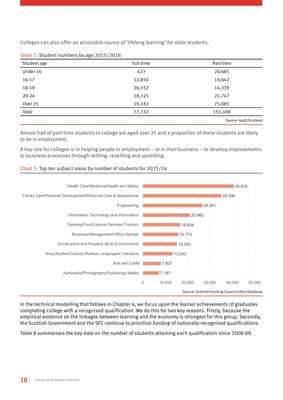
10 Fraser of Allander Institute
Colleges can also offer an accessible source of 'lifelong learning' for older students.
Table 7: Student numbers by age 2015/2016
Student age Full-time Part-time
Under 16 423 20,685
16-17 12,850 19,642
18-19 26,552 14,339
20-24 18,325 21,747
Over 25 19,182 75,085
Total 77,332 151,498
Source: Audit Scotland
Almost half of part-time students in college are aged over 25 and a proportion of these students are likely
to be in employment.
A key role for colleges is in helping people in employment - or in their business - to develop improvements
to business processes through skilling, reskilling and upskilling.
Chart 2: Top ten subject areas by number of students for 2015/16
7,187
7,927 13,243
15,202
15,773
16,634
20,96226,561
35,00640,633
0 10,000 20,000 30,000 40,000 50,000
Authorship/Photography/Publishing/ Media
Arts and Crafts
Area Studies/Cultural Studies/ Languages/ Literature
Construction and Property (Built Environment)
Business/Management/Office Studies
Catering/Food/Leisure Services/Tourism
Information Technology and Information
Engineering
Family Care/Personal Development/Personal Care & Appearance
Health Care/Medicine/Health and Safety
Source: Scottish Funding Council Infact Database
In the technical modelling that follows in Chapter 4, we focus upon the learner achievements of graduates
completing college with a recognised qualification. We do this for two key reasons. Firstly, because the
empirical evidence on the linkages between learning and the economy is strongest for this group. Secondly,
the Scottish Government and the SFC continue to prioritise funding of nationally-recognised qualifications.
Table 8 summarises the key data on the number of students attaining each qualification since 2008-09.